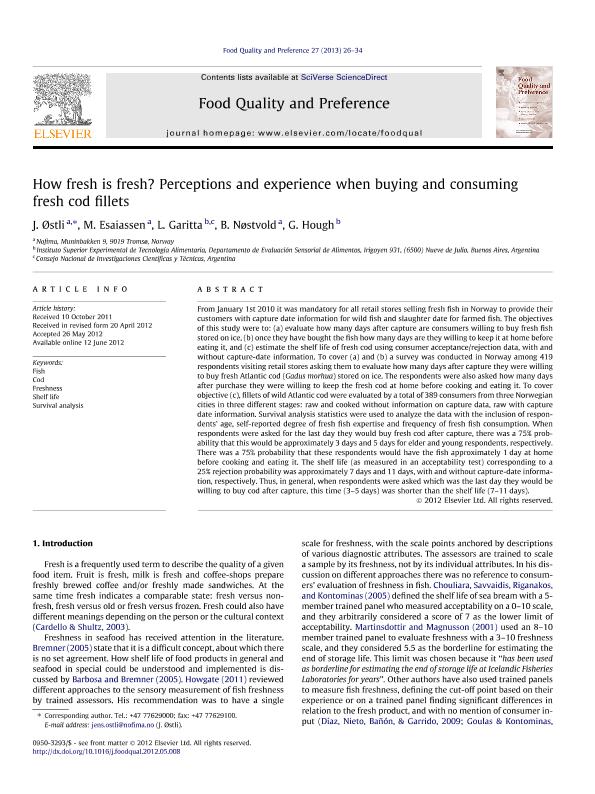Mostrar el registro sencillo del ítem
dc.contributor.author
Østli, J.
dc.contributor.author
Esaiassen, M.
dc.contributor.author
Garitta, Lorena Verónica

dc.contributor.author
Nøstvold, B
dc.contributor.author
Hough, Guillermo

dc.date.available
2017-08-25T22:00:01Z
dc.date.issued
2012-06
dc.identifier.citation
Østli, J.; Esaiassen, M.; Garitta, Lorena Verónica; Nøstvold, B; Hough, Guillermo; How fresh is fresh? Perceptions and experience when buying and consuming fresh cod fillets; Elsevier; Food Quality and Preference; 27; 1; 6-2012; 26-34
dc.identifier.issn
0950-3293
dc.identifier.uri
http://hdl.handle.net/11336/23082
dc.description.abstract
From January 1st 2010 it was mandatory for all retail stores selling fresh fish in Norway to provide their customers with capture date information for wild fish and slaughter date for farmed fish. The objectives of this study were to: (a) evaluate how many days after capture are consumers willing to buy fresh fish stored on ice, (b) once they have bought the fish how many days are they willing to keep it at home before eating it, and (c) estimate the shelf life of fresh cod using consumer acceptance/rejection data, with and without capture-date information. To cover (a) and (b) a survey was conducted in Norway among 419 respondents visiting retail stores asking them to evaluate how many days after capture they were willing to buy fresh Atlantic cod (Gadus morhua) stored on ice. The respondents were also asked how many days after purchase they were willing to keep the fresh cod at home before cooking and eating it. To cover objective (c), fillets of wild Atlantic cod were evaluated by a total of 389 consumers from three Norwegian cities in three different stages: raw and cooked without information on capture data, raw with capture date information. Survival analysis statistics were used to analyze the data with the inclusion of respondents’ age, self-reported degree of fresh fish expertise and frequency of fresh fish consumption. When respondents were asked for the last day they would buy fresh cod after capture, there was a 75% probability that this would be approximately 3 days and 5 days for elder and young respondents, respectively. There was a 75% probability that these respondents would have the fish approximately 1 day at home before cooking and eating it. The shelf life (as measured in an acceptability test) corresponding to a 25% rejection probability was approximately 7 days and 11 days, with and without capture-date information, respectively. Thus, in general, when respondents were asked which was the last day they would be willing to buy cod after capture, this time (3–5 days) was shorter than the shelf life (7–11 days).
dc.format
application/pdf
dc.language.iso
eng
dc.publisher
Elsevier

dc.rights
info:eu-repo/semantics/openAccess
dc.rights.uri
https://creativecommons.org/licenses/by-nc-sa/2.5/ar/
dc.subject
Fish
dc.subject
Cod
dc.subject
Freshness
dc.subject
Shelf Life
dc.subject
Survival Analysis
dc.subject.classification
Otras Agricultura, Silvicultura y Pesca

dc.subject.classification
Agricultura, Silvicultura y Pesca

dc.subject.classification
CIENCIAS AGRÍCOLAS

dc.title
How fresh is fresh? Perceptions and experience when buying and consuming fresh cod fillets
dc.type
info:eu-repo/semantics/article
dc.type
info:ar-repo/semantics/artículo
dc.type
info:eu-repo/semantics/publishedVersion
dc.date.updated
2017-08-25T19:53:48Z
dc.journal.volume
27
dc.journal.number
1
dc.journal.pagination
26-34
dc.journal.pais
Países Bajos

dc.journal.ciudad
Ámsterdam
dc.description.fil
Fil: Østli, J.. Nofima; Noruega
dc.description.fil
Fil: Esaiassen, M.. Nofima; Noruega
dc.description.fil
Fil: Garitta, Lorena Verónica. Provincia de Buenos Aires. Dirección General de Cultura y Educación. Instituto Superior Experimental de Tecnología Alimentaria. Departamento de Evaluación Sensorial de Alimentos; Argentina. Consejo Nacional de Investigaciones Científicas y Técnicas; Argentina
dc.description.fil
Fil: Nøstvold, B. Nofima; Noruega
dc.description.fil
Fil: Hough, Guillermo. Provincia de Buenos Aires. Dirección General de Cultura y Educación. Instituto Superior Experimental de Tecnología Alimentaria. Departamento de Evaluación Sensorial de Alimentos; Argentina
dc.journal.title
Food Quality and Preference

dc.relation.alternativeid
info:eu-repo/semantics/altIdentifier/url/http://www.sciencedirect.com/science/article/pii/S0950329312001048
dc.relation.alternativeid
info:eu-repo/semantics/altIdentifier/doi/http://dx.doi.org/10.1016/j.foodqual.2012.05.008
Archivos asociados
